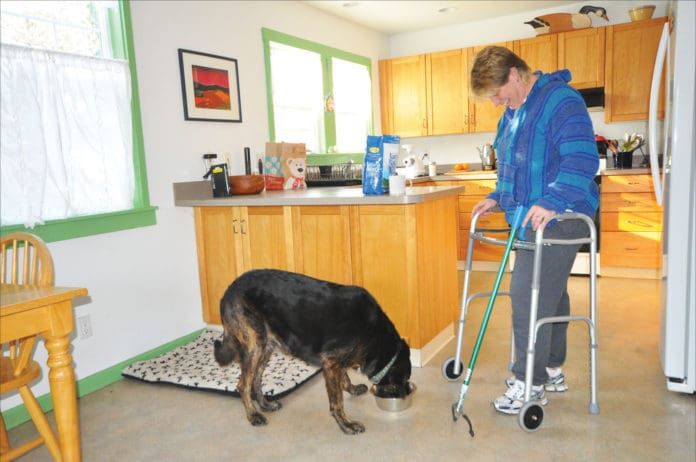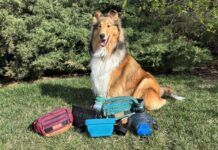No one likes to think about having major surgery. The thought of being temporarily disabled is scary enough, but when you factor in caring for your dog or dogs by yourself afterward, the fears multiply. Don’t worry! The following tips will help you navigate your recovery with ease while taking care of your canine companions. (The tips can easily be applied to caring for other pets as well.)
All of my suggestions are grounded in real-world experience. I was diagnosed with degenerative joint disease in both hips about three years ago. I was on a daily protocol of palliative measures until it became too much to bear the pain and restricted range of movement caused by this disease. At least I had (and needed) time to research a place for me and my two Siberian Huskies to stay before and after my surgery.
Fortunately, I have good friends who also have Siberians; they hosted my dogs for the two days I was in the hospital and then all three of us for a few more days, while I recuperated before transitioning to home. Having these details worked out way in advance allowed me to concentrate on the next vital challenge: preparing my house for our return in such a way that would take into consideration my post-surgery restrictions.
Walk On
I was lucky; I saved some equipment that my mother used following surgery she had a few years ago. I initially kept the tools because I wanted to use them with clients who were training their dogs to do hospital and nursing home visits. Little did I dream that years down the road I would be using these tools.
The first tool was a walker, which I would need (as my mom did) to move around the house after my surgery. My older dog Binks was used to seeing the walker because “Grandma” would come over with it when she baby-sat her “grand-dog.” My young girl Cricket was not used to it; she’s almost always a little wary around novel items. The saving grace is that she’s also curious.
I got the walker out and used it around the house a few times during the week before my surgery. It didn’t take that much time for her to get used to it, though if your dog is very wary or frightened of new things, I would suggest renting or buying a walker at least a couple of weeks before it is needed so that you can desensitize and counter-condition your dog to it.
Start acclimating your dog to the walker by positioning it in a highly trafficked location in your house, and placing super yummy treats near it. The next step is to touch it or lean on it while feeding high value treats to your furry friend. Allow it to creak or rattle in a natural manner, but don’t try to purposely frighten your dog with it! As long as your dog seems to accept it, increase your interaction with it until you are actually using the walker to move around the house, dropping tasty treats on the floor behind you while you walk with it. I recommend dropping them behind rather than in front of you; the last thing you need to have happen is for your dog to block your forward access and cause you to trip and fall. This is especially important if you have very small dogs.
After a few games of Hansel and Gretel (and the trail of breadcrumbs), your dog should associate the funny two-wheeled and tennis ball-covered appendage with good things. Using the walker prior to surgery will also give you the opportunity to see if any dog items such as beds and crates are in the path of your walker and will need to be moved to another location during your recuperation.
Note: If you have a ball-crazy dog, and your walker’s legs are covered with tennis balls, you may want to remove them or replace those rear walker legs with some other tip-protectors. Most drugstores sell handicap assistance accessories or you can go online to find them. Physical therapy practices can also give you a list of local medical supply stores where alternatives can be purchased.
Whatever Grabs You

Grabbing tools may appear to our dogs as an alien arm with a weird opposable thumb or a threatening weapon. But they are very useful for picking up tissues, clothes, and other personal items from floors or lightweight cooking items and supplies from shelves. I found one to be super helpful for picking up metal dog bowls from the floor, filling them with food, and then replacing them on the floor in my dogs’ eating places – especially after I strained my back and could not bend over without spasms overtaking me.
It’s very important to get used to using one of these tools a few weeks before your surgery, not only to get your furry friends used to it but also so you can develop the habit of using it. It’s so easy to forget your bending restrictions and suddenly lunge over to pick up that food bowl from the floor. If your body gets used to using this tool over a couple of weeks, it will be second nature to you by the time you have to depend on its daily use.
Poker anyone?
I’m actually talking about the wrought iron fire poker – not the card game! While the grabber is a great tool for picking up many things, it doesn’t do a great job of lifting anything heavy. I have a two-quart flat-backed water bucket outside for my dogs’ additional drinking needs. The grabber can’t lift or maneuver anything that heavy. That is when I spied the little hook extension on my fireplace poker. Voila! It worked perfectly to pick up the bucket so I could re-fill it and put it back down outside. If you don’t have a fireplace poker, an umbrella with a j-style handle will work well, as will the handle of a cane.
Yes I “Can”

The food bowl scenario was pretty easy to resolve. Picking up my dogs’ water bowls to clean and then fill presented another challenge. Their usual water bowl was a four-quart stainless steel bowl with sloped sides. There was no way the grabber was going to pick that up so that I could clean it and refill it. One thing that could help was to substitute their other smaller straight-sided stainless steel kennel bowl for their regular one, which solved the problem.
Now, how to fill it? Enter the garden-variety (literally) watering can with narrow spout. The narrow spout is very important. This allows you to stand up fairly straight and just tip your wrist slightly so that the stream of water goes directly down into the water bowl from a height of about 3 feet. This is by far my favorite use of an ordinary household item to solve my daily dog care challenges.
Believe in the Easter Bunny

I found that Easter baskets are the perfect shape and size for carrying dog food bowls, grooming items, or supplements from one area of the house to the other. Long, narrow basket handles are perfect for holding onto while you hold onto your walker arms. Plus, you can carry multiple items at once reducing the need to make many trips from one area of the house to the other end.
Those are the major things I found to be useful when I had my first hip replacement surgery. Before I have my next one, I plan to teach Cricket how to take off compression stockings; none of the dressing tools are really helpful with that!
Other preparations
In addition to gaining experience with the tools described above, it’s invaluable to prepare your home in other ways for your brief (we hope) disability.
For example, make sure you have an adequate supply of your dogs’ kibble or canned food, and place it in a location that makes it as easy as possible to retrieve and put in their bowls. If you feed a home-made diet, make sure to prepare (and freeze) enough for several weeks, as you may be tired and not up to extensive food preparation – yours or your dogs’! I feed mostly a dry food so I made sure that the week before my surgery I stocked up with a large enough bag to last a few weeks post-surgery. I also stocked up on treats, as well as my food and sundry items.
You may also want to have your dogs groomed before your big event; you will be in no position to do this for some time afterward.
I have medium-sized dogs so I don’t need to pick them up for any reason, but if you have tiny dogs, training them to jump up on a chair or sofa so that you can reach them without bending over can be very helpful.

Another thing to consider before your surgery is your dog’s response to common cues and his behavior in general. If he is rusty in responding to your cues to sit, leave it, or down, practice now so that he is up to speed well before your disability; this will pay off in spades for your recovery and his ease to acclimating to the temporary disruption of your normal life. If you don’t have the time for this or it’s beyond your capabilities, enlist the help of a good positive reinforcement-based trainer to help you polish your dog’s rough behavioral edges.
Getting help
If you have very small, senior, or couch-potato dogs, they may be perfectly happy to keep you company in your newly less-active life. But if your dogs are young and/or highly active, they may be unable to adjust to a suddenly sedentary schedule. Do all of you a favor and find, interview, and get your dogs accustomed to going out with a professional dog walker or enlist the help of trusted dog-savvy friends to help out. Do this far enough in advance of your surgery so you have time to find another person if the first one doesn’t work out! And then schedule the person for as many walks as your dogs will need in order to reliably stay calm at home.
If you are unable to allow your dog to potty outside in your fenced yard, your new dog-walker or trusted friends may be able to help by taking your dog out to potty and then cleaning up after her.
Stress reduction
Doing all of the pre-op preparations above helped to de-stress me before my surgery. I’m very much an independent type of person, so having to rely on others was difficult for me.
The only thing that I needed to have help with was someone to walk my dogs. As soon as I was able, I started picking up after my dogs in the yard, using the long-handled pooper scooper set I started using after my back strain. And soon enough, because I hadn’t hurt myself by overdoing household and dog-care tasks, I recovered – and improved on! – my previous mobility. It was a relief to be self-sufficient again.







This article was very helpful and informative. I broke by upper back and sternum. My husband has tired to help but get overwhelm at times. U have given me some alternative idea d